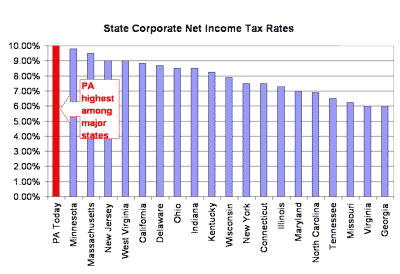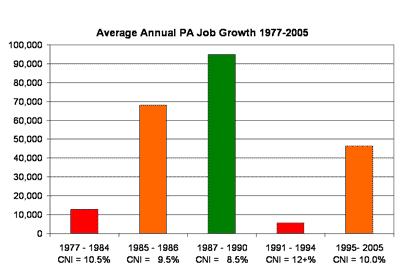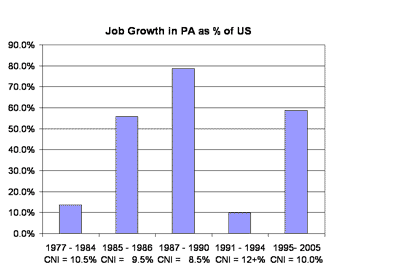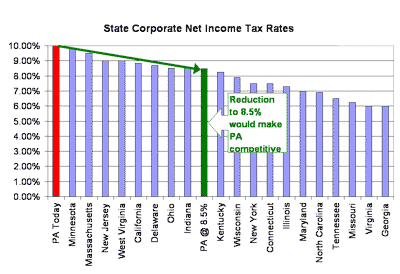Will the State Use Its Surplus to Become More Competitive?
As the end of June approaches, so does the deadline for passing a state budget in Pennsylvania for the 2006-2007 fiscal year. In years when the budget was facing a deficit, the state has increased taxes to pay for it. Since the state is projecting a more than $700 million surplus in the current fiscal year, will it use that to reduce taxes in order to be more competitive?
Despite the daily media attention the property tax receives, it is not the most uncompetitive tax in Pennsylvania. The most uncompetitive tax is the state Corporate Net Income (CNI) tax. Pennsylvania currently has the second highest CNI tax rate in the nation. Only Iowa is higher. Pennsylvania has the highest CNI tax rate of any major state.

When one takes into account all of the taxes that businesses pay in Pennsylvania and other states, at both the state and local level, Pennsylvania's business tax burden ends up being about average among states. But many businesses never get to the point of realizing that, because the most visible measure of business taxes is the CNI rate, and on that, Pennsylvania sticks out like a sore thumb.

Does this have an impact on job creation? The data suggest it does. Pennsylvania's CNI rate was 8.5% between 1987 and 1990, the most competitive rate in the past 30 years. That was also when Pennsylvania had the highest rate of job creation in the past thirty years -- almost 100,000 net new jobs were created per year during that period. When the CNI tax rate was raised to 12.25% to help balance the budget in 1991, job creation fell to fewer than 6,000 jobs per year, a 95% reduction, and the lowest level in the past 30 years. Job creation recovered in the mid-90s after the CNI rate was lowered to the current 9.99% level, but since that tax rate was still high, job creation did not fully recover -- the average rate of job creation over the past 10 years has still only been half of what it was at the end of the 1980s when the CNI rate was even lower.

Some of the changes in Pennsylvania's job creation during these periods were a function of the national economy, not the business tax rate. But if you compare Pennsylvania's job creation to the U.S rate, you see the same pattern. Pennsylvania's best performance compared to the U.S. occurred when the CNI rate was the lowest, and it worst relative performance occurred when the CNI rate was the highest. In fact, the only time in the past 30 years when Pennsylvania's job creation rate matched the U.S. was in 1987, when the CNI rate was 8.5%.
In short, when Pennsylvania's CNI rate was most competitive, Pennsylvania's job creation rate was highest. When its CNI rate was least competitive, its job creation rate suffered.
The high CNI rate is not the only problem with Pennsylvania's business tax structure. Pennsylvania is also one of only two states that puts a cap on the amount of losses from one tax year that a company can carry over to future tax years (what's called the Net Operating Loss Carryforward). The only other state that does that is New Hampshire, so once again Pennsylvania is the least competitive of any major state. Pennsylvania also still has a Capital Stock and Franchise Tax on top of the CNI tax. It's being phased out, which is a good thing, but even when it's gone, Pennsylvania will still be uncompetitive due to the problems with the CNI.
The Governor has proposed using part of the surplus to accelerate the phaseout of the Capital Stock and Franchise Tax. That's desirable, but he also needs to reduce the rate of the CNI. Most of the Governor's proposal for the surplus is for new spending, not tax reductions.

How much would it cost to make Pennsylvania's Corporate Net Income Tax competitive? If the state reduced the CNI tax rate to 8.5% in phases over a four year period, starting next Janary, it would only cost about $33 million in next year's budget -- less than 5% of the projected budget surplus. Pennsylvania could immediately lose the distinction of having the highest CNI of any major state, and would move down to 15th by 2010. Eliminating the cap on NOL carryforwards and creating a single sales factor, two other very important changes, could be phased in for an additional cost of about $20 million in next year's budget.
The evidence of the past 30 years suggests that these changes would boost business and job creation, which would in turn increase state revenues, not just from corporate taxes, but also from personal income and sales taxes. In fact, it would only take a modest increase in the state's growth rate to pay for the "cost" of the tax reduction.
Let's get rid of this obvious red flag for job creation and make Pennsylvania's business taxes competitive for the first time in 15 years. Contact the Governor and contact your State Representative and State Senator today (you can email them) to urge them to reduce the Corporate Net Income tax rate as part of the 2006-2007 state budget.
Despite the daily media attention the property tax receives, it is not the most uncompetitive tax in Pennsylvania. The most uncompetitive tax is the state Corporate Net Income (CNI) tax. Pennsylvania currently has the second highest CNI tax rate in the nation. Only Iowa is higher. Pennsylvania has the highest CNI tax rate of any major state.

When one takes into account all of the taxes that businesses pay in Pennsylvania and other states, at both the state and local level, Pennsylvania's business tax burden ends up being about average among states. But many businesses never get to the point of realizing that, because the most visible measure of business taxes is the CNI rate, and on that, Pennsylvania sticks out like a sore thumb.

Does this have an impact on job creation? The data suggest it does. Pennsylvania's CNI rate was 8.5% between 1987 and 1990, the most competitive rate in the past 30 years. That was also when Pennsylvania had the highest rate of job creation in the past thirty years -- almost 100,000 net new jobs were created per year during that period. When the CNI tax rate was raised to 12.25% to help balance the budget in 1991, job creation fell to fewer than 6,000 jobs per year, a 95% reduction, and the lowest level in the past 30 years. Job creation recovered in the mid-90s after the CNI rate was lowered to the current 9.99% level, but since that tax rate was still high, job creation did not fully recover -- the average rate of job creation over the past 10 years has still only been half of what it was at the end of the 1980s when the CNI rate was even lower.

Some of the changes in Pennsylvania's job creation during these periods were a function of the national economy, not the business tax rate. But if you compare Pennsylvania's job creation to the U.S rate, you see the same pattern. Pennsylvania's best performance compared to the U.S. occurred when the CNI rate was the lowest, and it worst relative performance occurred when the CNI rate was the highest. In fact, the only time in the past 30 years when Pennsylvania's job creation rate matched the U.S. was in 1987, when the CNI rate was 8.5%.
In short, when Pennsylvania's CNI rate was most competitive, Pennsylvania's job creation rate was highest. When its CNI rate was least competitive, its job creation rate suffered.
The high CNI rate is not the only problem with Pennsylvania's business tax structure. Pennsylvania is also one of only two states that puts a cap on the amount of losses from one tax year that a company can carry over to future tax years (what's called the Net Operating Loss Carryforward). The only other state that does that is New Hampshire, so once again Pennsylvania is the least competitive of any major state. Pennsylvania also still has a Capital Stock and Franchise Tax on top of the CNI tax. It's being phased out, which is a good thing, but even when it's gone, Pennsylvania will still be uncompetitive due to the problems with the CNI.
The Governor has proposed using part of the surplus to accelerate the phaseout of the Capital Stock and Franchise Tax. That's desirable, but he also needs to reduce the rate of the CNI. Most of the Governor's proposal for the surplus is for new spending, not tax reductions.

How much would it cost to make Pennsylvania's Corporate Net Income Tax competitive? If the state reduced the CNI tax rate to 8.5% in phases over a four year period, starting next Janary, it would only cost about $33 million in next year's budget -- less than 5% of the projected budget surplus. Pennsylvania could immediately lose the distinction of having the highest CNI of any major state, and would move down to 15th by 2010. Eliminating the cap on NOL carryforwards and creating a single sales factor, two other very important changes, could be phased in for an additional cost of about $20 million in next year's budget.
The evidence of the past 30 years suggests that these changes would boost business and job creation, which would in turn increase state revenues, not just from corporate taxes, but also from personal income and sales taxes. In fact, it would only take a modest increase in the state's growth rate to pay for the "cost" of the tax reduction.
Let's get rid of this obvious red flag for job creation and make Pennsylvania's business taxes competitive for the first time in 15 years. Contact the Governor and contact your State Representative and State Senator today (you can email them) to urge them to reduce the Corporate Net Income tax rate as part of the 2006-2007 state budget.


2 Comments:
"When one takes into account all of the taxes that businesses pay in Pennsylvania and other states, at both the state and local level, Pennsylvania's business tax burden ends up being about average among states. But many businesses never get to the point of realizing that, because the most visible measure of business taxes is the CNI rate, and on that, Pennsylvania sticks out like a sore thumb."
Things like this drive me crazy: shouldn't corporate location consultants be able to calculate this?
So much public policy is based on the spurious notion that businesses are rational economic actors when often they are not. I suppose this helps your argument that the CNI rate should be reduced.
There are two reasons why this happens. First, the actual business tax burden can't be accurately calculated until a business picks a particular spot to consider, because the local taxes vary from locality to locality. The statement that Pennsylvania's total state and local tax burden is average is based on comparing an "average" location in Pennsylvania to "average" locations in other states. It is, of course, possible, that a business can be considering a higher-than-average tax location in one state and a lower-than-average tax location in another state.
The second reason is that increasingly, corporations pick the short list of states/regions themselves, and then ask the location consultant to do the detailed analysis on that short list. The short list often gets created based on anecdotal information and data that are easily available on the internet. It's very easy to find out what Pennsylvania's CNI rate is on the internet. It's very hard to find out all of the different taxes that exist in every state and locality and all of the nuances (not only the rates, but what the tax applies to). So if you just want a quick way to shorten the list, the CNI is an easy one to use, particularly since most businesses would assume that a state that has the second-highest CNI probably doesn't care much about attracting/retaining businesses, and so there's no need to do a more detailed evaluation of business climate.
Post a Comment
<< Home